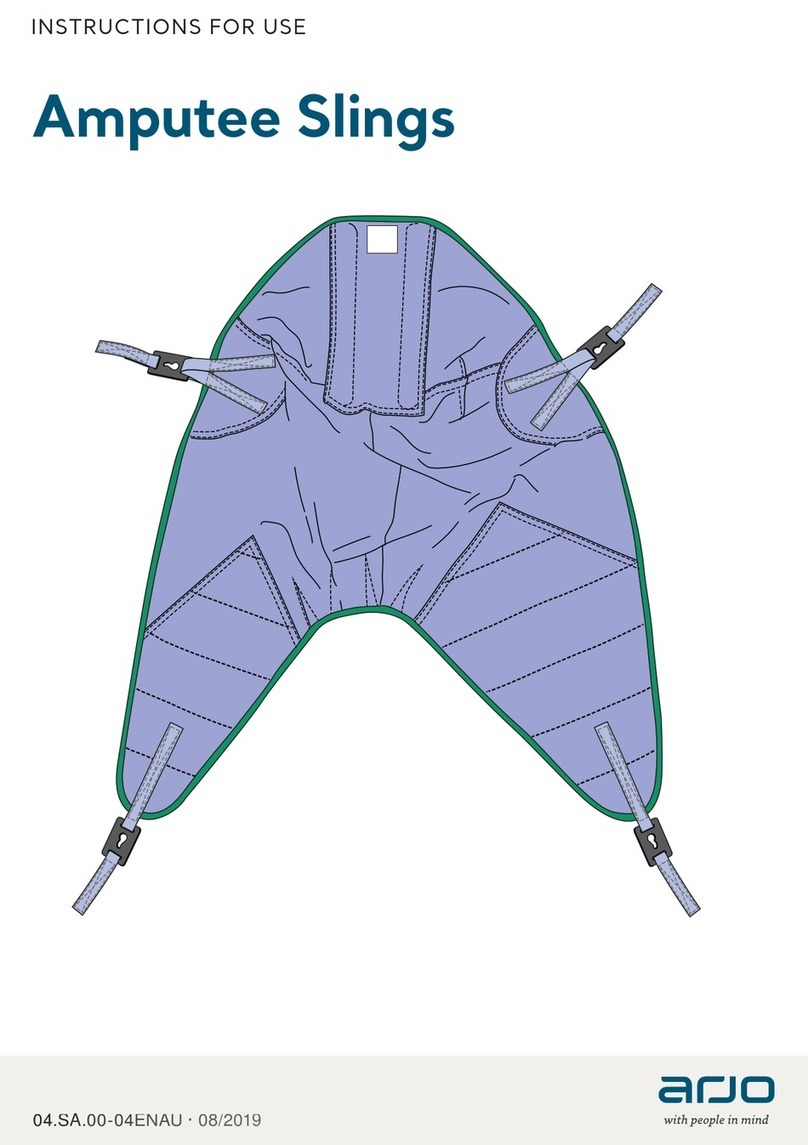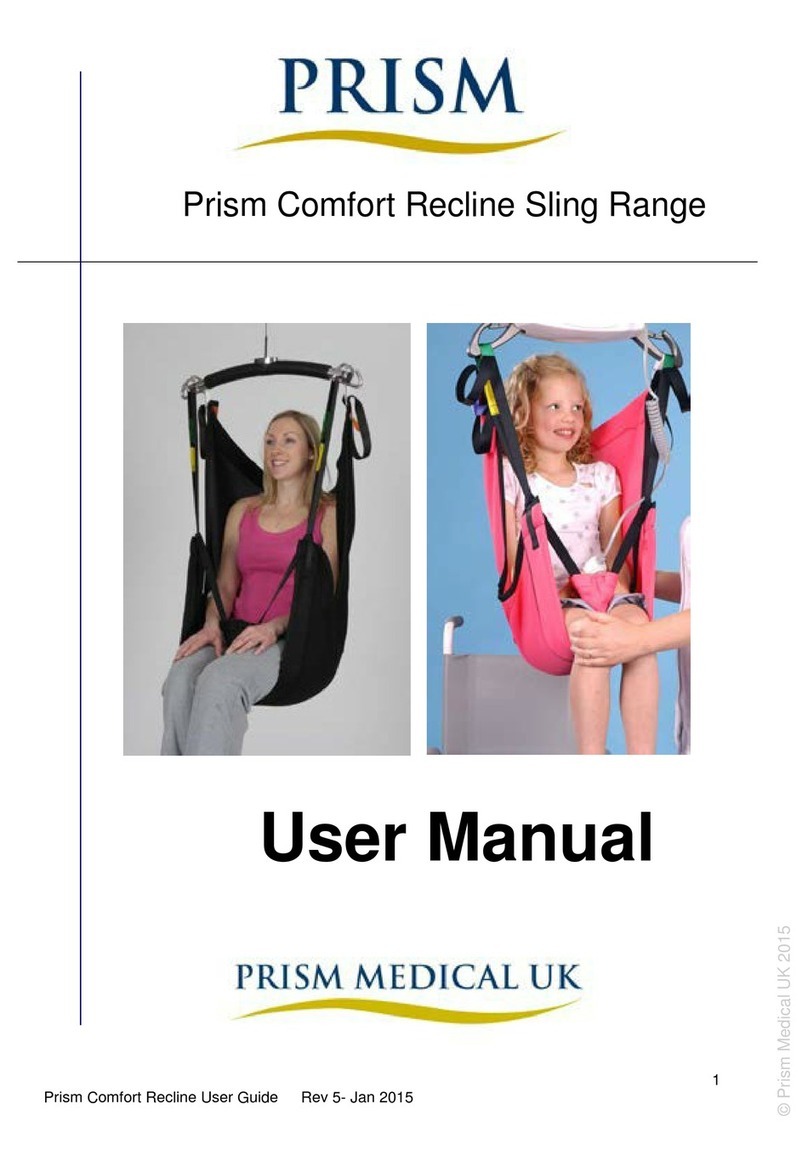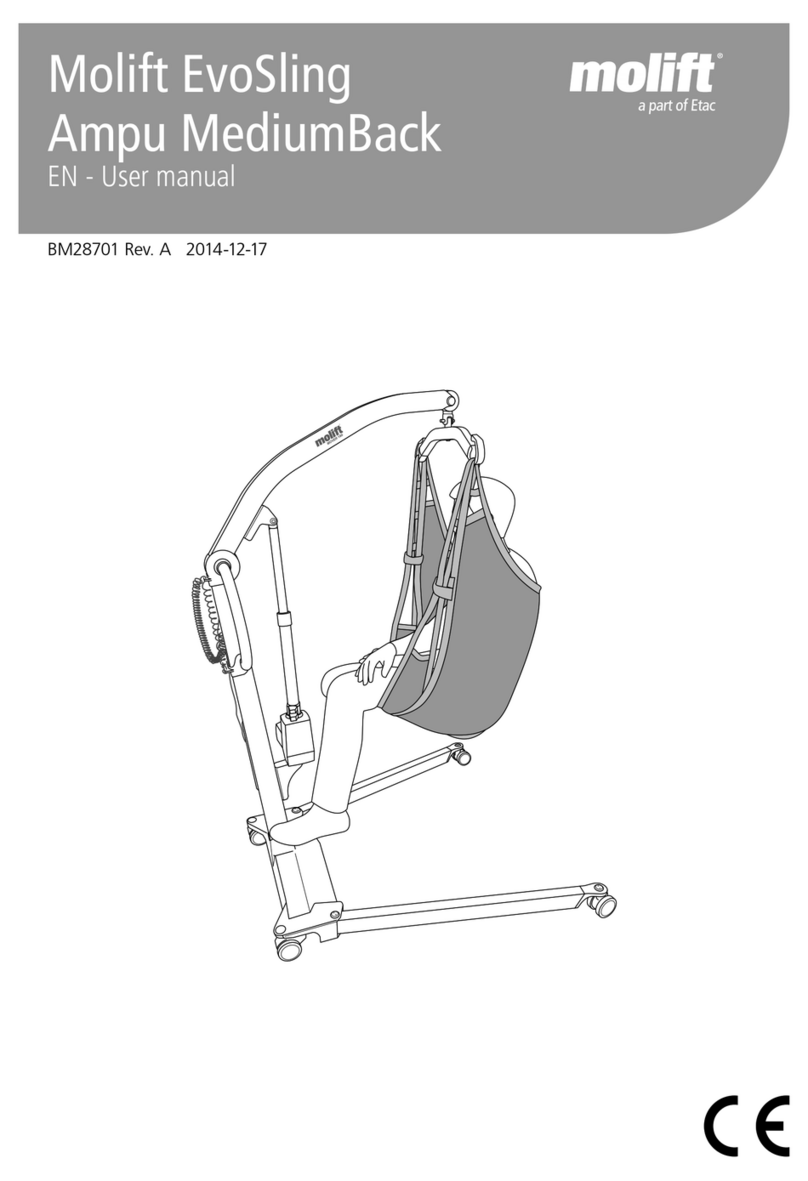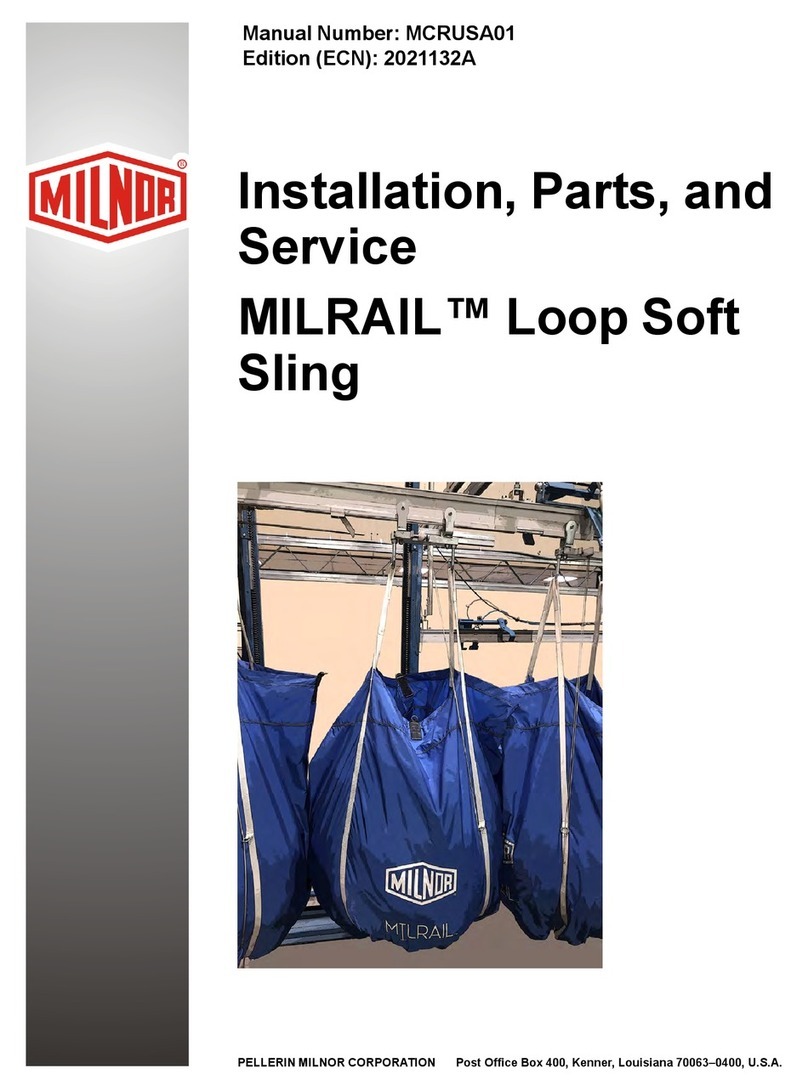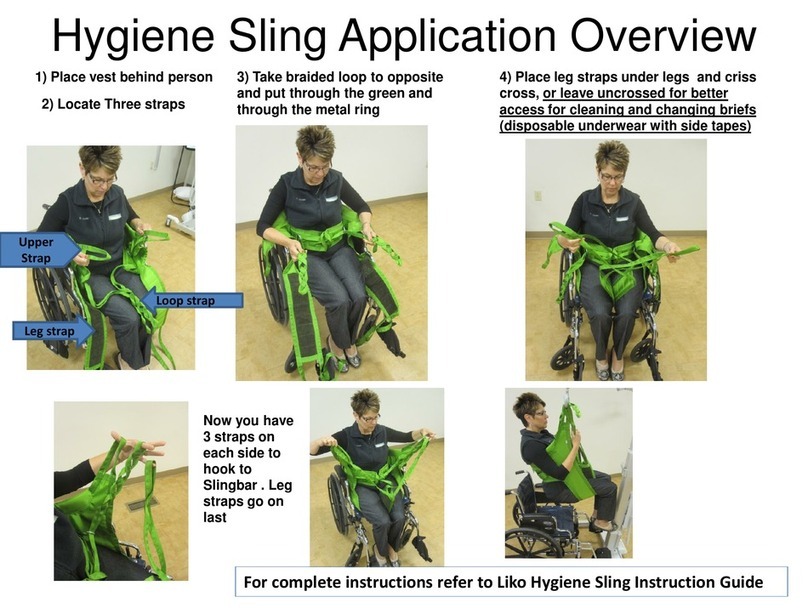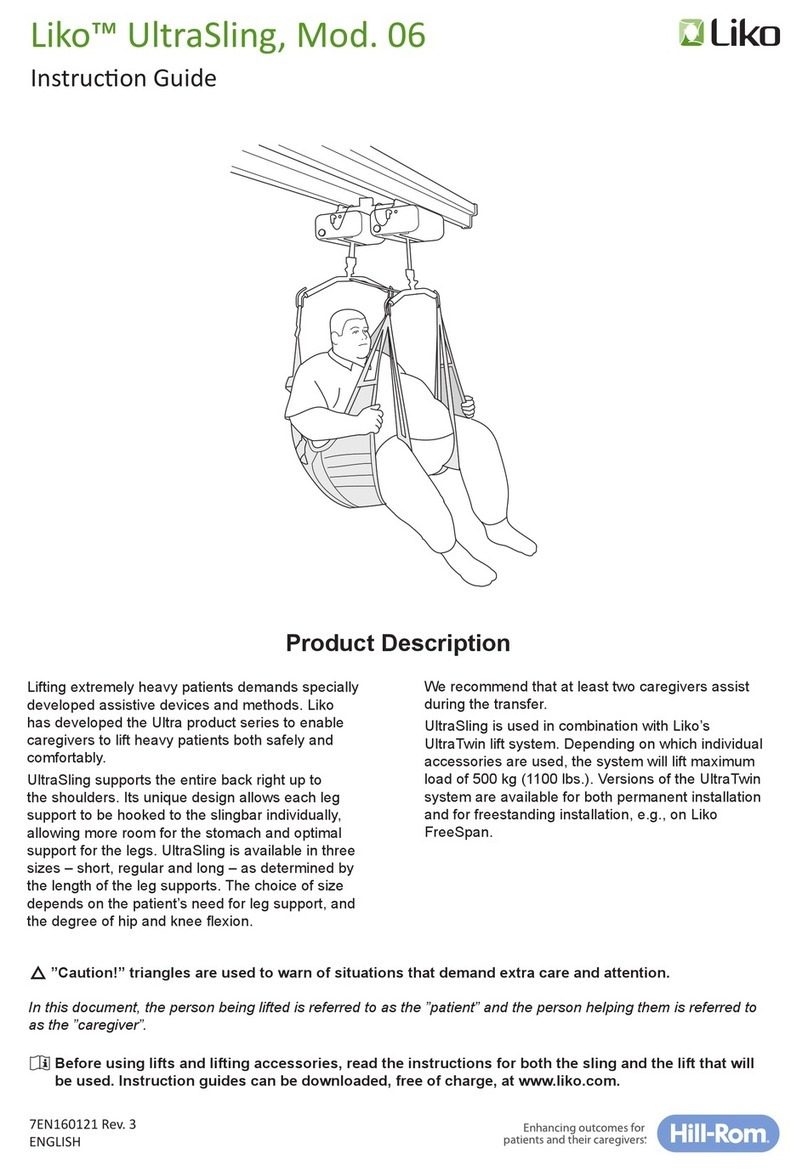Hillrom UniversalSling 000 Manual

Liko UniversalSling is a basic model which is
designed to adapt to the patient without individual
adjustments and is one of our most used slings.
The UniversalSling provides an upright sitting posture
and supports the entire back up to the neck.
The patient’s arms are held inside the sling. A properly
tted and carefully applied UniversalSling will give
the patient an excellent sense of safety, as well as
a high degree of comfort.
Sizes
The UniversalSling is available in different sizes. It is
important to choose the correct size to achieve the
highest level of comfort and safety. A sling which is too
large increases the risk of the patient sliding out of it,
while one which is too small can cut into the groin and
cause discomfort.
For larger sizes, a combination with Liko Universal
TwinBar 670 can be a good choice.
Fabrics
The UniversalSling is available in different fabrics.
Since the UniversalSling is not usually left under the
patient after the transfer, we recommend the polyester
design. This fabric is durable and has low friction
making the sling easy to apply and easy to remove.
is a warning triangle used for situations which require extra care and attention.
In this document, the person being lifted is referred to as the patient and the person helping is referred to
as the caregiver.
Read the instruction guide for both the sling and the lift being used. Instruction guides can be downloaded,
free of charge, at www.liko.com.
Liko UniversalSling™, Mod. 000, 002
Instruction Guide
English
7EN161110-06
Product Description
The UniversalSling is also available in net polyester.
This fabric is recommended when the sling is left in
place after the transfer or when an airier alternative
is desired.
For bathing and showering, a plastic-coated net
design is available, which is water permeable and
can easily be wiped. This material dries quickly and
does not chill the patient in the same way as a damp,
absorbent fabric would.
The sling’s lift straps are always made of durable
polyester and are very secure.
Leg Supports
The UniversalSling is available with leg supports
in several different designs. Most common are leg
supports with reinforcements. The reinforcement
provides high comfort, equalizes pressure and
prevents the sling from creasing under the thighs.
There is also a version with soft-padded leg supports
(synthetic sheepskin). This design is suitable for
patients who are especially sensitive to pressure.
Liko Universal HighLevel Sling, Mod. 002
The UniversalSling Mod. 002 is recommended
for transfers where there is a problem to achieve
sufcient lifting height. The suspension loops are
minimised, and the sitting posture is slightly more
reclined than with Model 000.

2www.liko.comLiko UniversalSling, Mod. 000, 002 • 7EN161110-06
Before lifting, keep the following points in mind:
• A responsible person within your organization should decide on a case-by-case basis whether one or more
caregivers are needed.
• Ensure that the sling selected meets the patient’s needs with reference to model, size, fabric and design.
• For safety and hygiene reasons, use individual slings.
• Before lifting, plan the lifting operation so that it can be done as safely and smoothly as possible.
• Before lifting, check that the lifting accessory hangs vertically and can move freely.
• Although the Liko sling bars are equipped with latches, special caution must be exercised: before the patient
is lifted from the underlying surface, but when the straps are fully extended, make sure the straps are correctly
connected to the sling bar hooks.
• Make sure the patient is sitting securely in the sling before transferring to another location.
• Never lift a patient higher off the underlying surface than is needed to complete the lifting and transfer procedure.
• Never leave a patient unattended during a lifting situation.
• Make sure that the wheels on the wheelchair, bed, gurney, etc., are locked during the lifting/transfer operation.
• Always work ergonomically. Use the patient’s ability to actively participate in the operations.
• When the sling is not being used, do not place in direct sun light.
Safety Instructions
Liko’s products undergo continuous development, which is why we reserve the right to make product changes
without prior notice. Contact your Liko/Hill-Rom representative for advice and information about product upgrades.
The shortening position design is patent pending.
The design of the First Use label is patent pending.
Medical Class I Product
Liko UniversalSling has been tested by an accredited testing institute and complies with all requirements for MDD
Class I products and the harmonized EN ISO 10535:2006 standard.
IMPORTANT!
Lifting and transferring a patient always involves a certain risk. Read the instruction guide for both the lift and
lifting accessories before use. It is important to completely understand the contents of the instruction guide.
The equipment should be used only by trained personnel. Ensure that the lifting accessories are suitable for
the lift being used. Exercise care and caution during use. As a caregiver, you are always responsible for the
patient’s safety. You must be aware of the patient’s ability to handle the lifting situation.
Liko is quality certied in accordance with ISO 9001 and its equivalent for the medical device industry, ISO 13485.
Liko is also certied in accordance with environmental standard ISO 14001.
Design and Quality by Liko in Sweden
Before the sling is used the rst time, the date (year and month) should be marked on the label ”First Use” (placed
under the label ”Perform Inspection”), please see the example below. The marking is made by cutting the green
threads in the relevant squares. The threads are cut with one cut in the middle of the square. Do not cut off the
threads completely - let the cut thread ends remain.
Before First Use !
Example: February 2014 Cut the threads in the
middle of the square.
Year
First Use
End of Use
Expected Life - 5 years
123456
7 8 9 10 11 12
Month
2014 2015 2016 2017 2018
2019 2020 2021 2022 2023
Year
184490 rev 1
Year
First Use
End of Use
Expected Life - 5 years
123456
7 8 9 10 11 12
Month
2014 2015 2016 2017 2018
2019 2020 2021 2022 2023
Year
184490 rev 1

3
Liko UniversalSling, Mod. 000, 002 • 7EN161110-06 www.liko.com
Care and Maintenance
Check the sling before each use. Check the following points with regard to wear and damage:
• Fabric
• Straps
• Seams
• Suspension loops
Do not use damaged lifting accessories.
If anything is unclear, please contact the manufacturer or supplier.
If the sling is used for bath or shower: After use in bath and shower situations, the sling should be placed so that
it dries as soon as possible.
Washing Instructions: Please see the sling’s product label and the attached appendix ”Care and Maintenance of
Liko Slings”.
Expected Life
If the product is made of green woven polyester fabric, the product has an expected life of 5 years. If the product
is made of plastic coated net or grey net polyester, the product has an expected life of 3 years. The expected life is
based on 10 uses per day and washing once per week, according to washing instructions. Hill-Rom recommends
the product be used only during its expected life.
Periodic Inspection
The product must be inspected at least once every 6 months. More frequent inspections might be required if the
products are used or washed more often than normal. See Liko’s protocol Periodic Inspection for the respective
product.
Denitions
7
6
2
1
8
11
10
5
9
14
13
12
341. Product label
2 Label: Manufacturing year and month ( )
3. Label: Serial number (S/N)
4. Label: Individual marking (Belongs to)
5 Label: Check and inspect (Perform Inspection)
6. Label: The rst time the product is used (First Use)
7. Upper strap loop
8. Handle
9. Leg support
10. Shortening position (mod 000)
11. Outer leg support loop
12. Lower edge
13. Centre back strap
14. Size marking

4www.liko.comLiko UniversalSling, Mod. 000, 002 • 7EN161110-06
Lifting from the Sitting Position
Place the sling behind the patient’s back with the product
label outwards. Fold up the lower edge of the sling
around your nger tips to facilitate guiding the sling
into place.
Using the palm of your hand, push the lower edge
of the sling down to the level of the patient’s coccyx -
this is very important. Note: Correct positioning is
facilitated if the patient leans/is leaned forward slightly.
Pull the sling’s leg supports forward along the outside
of the patient’s thighs. Place the palm of your hand
between the patient’s body and the sling and push
the leg support’s lower edge down towards the seat.
Simultaneously, pull the leg support forward with the
other hand to stretch it.
Pull the leg supports forward to smooth out any creases
in the back. Check that both leg supports protrude the
same distance. Note: A gentle hold under the knee-cap
makes it easier to pull the leg supports forward.
Insert the leg supports under each thigh. Make sure
the fabric lies at and that it reaches properly around
the leg. Note: The application of the leg supports is
facilitated if the patient’s legs are slightly raised from the
seat. This can be achieved by placing the patient’s feet
on the foot-rests or on your own leg, as illustrated.
Prepare the connection of the leg supports. The most
common way of applying the sling is with crossed leg
supports. For alternative methods, see page 8.

5
Liko UniversalSling, Mod. 000, 002 • 7EN161110-06 www.liko.com
First connect the upper strap loops to the sling bar hooks,
then the leg support loops. Lift.
Note: Check that all suspension loops have the same
length, i.e., are at an equal height when they are
stretched prior to lifting. Adjust the position of the sling
if they are not at an equal height.
Lifting to the Sitting Position
When placing a patient in a wheelchair, it is important that the patient gets far enough back in the chair to sit well.
This can be accomplished in several ways.
When placing a patient in a wheelchair: Lean the
chair backwards during the lowering of the patient.
Let the buttocks slide down the backrest during
the last part. Control the angle of the wheelchair
with your foot on the tipping support.
Alternative: Apply slight pressure under the patient’s
knees during the lowering sequence, so that the
buttocks are guided towards the backrest of the chair.
If the sling has handles, these can be used to guide.
Do not use the handles to lift! Excessive force
on the handles can cause the sling to tear.
Carefully remove the leg supports. The gentlest way
of doing this is by pulling out the leg support loops
under the fabric part.
Remove the sling by carefully pulling the leg support up.
We recommend removing the sling after the transfer. If for some reason it is preferable to leave the sling in the
chair after transfer, we recommend using a sling in net polyester.
Removing the Sling in a Chair/Wheelchair

6www.liko.comLiko UniversalSling, Mod. 000, 002 • 7EN161110-06
Lifting from the Bed
The sling can be applied in different ways depending of the status of the patient. Either it is applied with the patient
lying in bed or sitting in bed. If an advanced pressure-relieving mattress is used, it can to advantage be inated
maximally to facilitate the application of the sling.
Remember your own work posture and the patient’s comfort. Use the bed’s functions for raising and lowering.
Good work posture is obtained when the mattress is level with the caregiver’s knuckles when the arms are held
completely down. Depending on the burden on the caregiver, an evaluation of how many caregivers are needed
for the operation must be made on a case to case basis.
Turn the patient to the side. This operation is facilitated
if the patient himself can contribute by gripping the bed
rail on the side to which he is to be turned. Place the
edge of the sling towards the back of the patient with
the lower edge level with the coccyx.
Applying the Sling when Sitting in Bed
Raise the head end of the bed behind the patient. Lay the sling on the bed with the product label facing down
towards the mattress. Slide the sling down behind the patient’s back so that the lower edge is level with the
coccyx. Note! The application is facilitated if the patient leans/is leaned forward.
Raise the head end of the bed. First connect the upper
strap loops to the hooks of the sling bar, then the leg
support loops. Lift.
Insert the leg supports under each leg. This is best
done by pressing the leg support down against the
mattress while inserting it under the knee. Make sure
the fabric lies at and that it reaches properly around
the leg. The leg supports can be connected in different
ways, see page 8.
Applying the Sling when Lying in Bed
For lifting from a supine position without the possibility of raising the head end of the bed or otherwise supporting
the head, we recommend Liko Soft Original HighBack Sling Mod. 26, or alternatively Liko Original HighBack Sling
Mod. 20, 21, which all provide support for the head.
Fold the sling so that its "centre back strap" corresponds
to the patient’s spine. Check that the fold covers the
sling’s edge which is in towards the back of the patient
in order to reduce the friction. Turn back the patient
gently and pull out the sling on the other side. With this
application technique, the patient needs to be turned
once only.

7
Liko UniversalSling, Mod. 000, 002 • 7EN161110-06 www.liko.com
Removing the Sling when Sitting in Bed
Position the patient above the bed.
Raise the head end of the bed for
the patient’s comfort. Lower the
patient onto the bed.
Remove the leg supports by pulling
out the leg support loops under the
fabric part. Note: This is facilitated
if the patient’s legs are bent.
Remove the sling by pulling one
of the leg supports behind the sling
and over to the opposite side.
Removing the Sling when Lying in Bed
Position the patient above the bed. Raise the head end
of the bed for the patient’s comfort. Lower the patient
onto the bed. Lower the head end.
Place the leg support loops under the leg supports
between the patient’s legs.
Grasp the edge of the sling. Push in the sling under
itself. Press the sling against the mattress and in under
the patient.
Carefully turn the patient onto the side. Grasp the sling
from below and remove it carefully.
We recommend removing the sling after the transfer. If for some reason it is preferable to leave the sling in the bed,
we recommend using a sling made of net polyester.
Remember your own work posture and the patient’s comfort. Use the bed’s functions for raising and lowering.
Good work posture is obtained when the mattress is level with the caregiver’s knuckles when the arms are held
completely down. Depending on the burden on the caregiver, an evaluation of how many caregivers are needed
for the operation must be made on a case to case basis.
Lifting to the Bed

8www.liko.comLiko UniversalSling, Mod. 000, 002 • 7EN161110-06
Lifting to/from the Toilet
For lifting to/from the toilet with UniversalSling according to the "pants trick", please see separate instructions.
There are several other slings in the Liko range that can be used for lifting to/from the toilet, e.g. Liko HygieneSling
and Liko HygieneVest.
Different Ways of Connecting Leg Supports
Crossed-over leg supports.
The most common way of applying
the sling. One leg support loop is
passed through the other before the
loops are connected to the sling bar.
Overlapped under both thighs.
This can be appropriate, for example
when lifting a patient with amputated
legs. Note: In order to avoid the
patient’s sitting posture being too
reclined, Extension Loops can be
attached to the leg support loops.
Each leg support connected
separately to the sling bar.
This can be appropriate when lifting
patients with particularly sensitive
genitals.
Increased risk of sliding out.
The Patient does not Sit Well in the Sling – Why is this?
The lower edge of the sling is at the same
level as the coccyx. The leg supports are
properly positioned under the legs.
A. Risk of sliding out. The buttocks hang down.
The sling may be too large. It can also be due to the fact
that the sling has not been pulled down the patient’s
back sufciently.
Before lifting, check that the lower edge is stretched
and that the fabric reaches properly around the legs.
B. Too small sling can cause the leg supports to cut into
the crotch causing discomfort, the sling bar to be too close
to the face and/or the back to get insufcient support.
Fitting Advice
Before a connection alternative is chosen, an individual assessment should be performed to anticipate possible risks.
RIGHT!
WRONG!
A. B.

9
Liko UniversalSling, Mod. 000, 002 • 7EN161110-06 www.liko.com
Our sling models are carefully designed to ensure that the patient always sits with pressure well distributed
between legs and back section for good support during transfers. However, in certain cases it can be preferable
to use the inner setting, the ”shortening position”, on the leg support loop to change the patient’s sitting position.
Note: This does not apply if you have an older model of the UniversalSling, Mod. 00/02, with an earlier design of
the shortening position. For a description of the shortening procedure for Mod. 00/02, please contact Liko/Hill-Rom
to obtain the instruction guide for that model.
In cases where the shortening position is used, we recommend that you also connect the outer leg support loop to
the sling bar hook in order to have better visual control of the loops.
3500- --5
Overview Liko UniversalSling, Mod. 000, 002
Product Prod. No. Size Patient’s Weight¹ Max. Load²
¹ The indicated patient weight is a guideline only - there may be deviations.
² To maintain maximum load, lift/accessories intended for the same load or more are required.
0 Without reinforcement or padding in leg supports
1 Reinforced leg supports
2 Padded with synthetic sheepskin in leg supports
1 Polyester 3 Net polyester 4 Plastic-coated net
Liko UniversalSling 35000 - - 4 S 35-55 kg (77-121 lbs) 200 kg (440 lbs)
Liko UniversalSling 35000 - - 1 M-Slim (slim adult) 45-70 kg (99-154 lbs) 200 kg (440 lbs)
Liko UniversalSling 35000 - - 5 M 60-90 kg (132-198 lbs) 200 kg (440 lbs)
Liko UniversalSling 35000 - - 6 L 80-120 kg (176-264 lbs) 200 kg (440 lbs)
Liko UniversalSling 35000 - - 7 XL 110- kg (242- lbs) 300 kg (660 lbs)
Liko Universal HighLevel Sling 35002 - - 5 M 60-90 kg (132-198 lbs) 200 kg (440 lbs)
Liko Universal HighLevel Sling, 35002 - - 6 L 80-120 kg (176-264 lbs) 200 kg (440 lbs)
Indicates size
Indicates sling model
Shortening Position
Shortening Position

Slim 350
Standard 450
Wide 670
Cross-Bar
Recommended combinations
of the Liko UniversalSling
and Liko’s sling bars:
Universal 350
Universal 450
Mini 220
Sling
Cross-Bar 450
Sling
Cross-Bar 670
Univ. TwinBar 670
SideBars +
Slim 350
Univ. SideBars +
Universal 350
SideBars +
Standard 450
Univ. SideBars +
Universal 450
UniversalSling, S 3 2 2 1 1 3 2 2 1* 1 2 3 2 2 2
UniversalSling, M-Slim 3 2 2 1 1 3 1 1 1* 1 1 3 1 2 1
UniversalSling, M 3 2 2 1 1 3 1 1 1* 1 1 3 1 2 1
UniversalSling, L 3 2 2 1 1 1 1 1 2* 1 1 3 1 2 1
UniversalSling, XL 3 3 3 2 2 1 1 1 2* 1 1 3 1 1 1
Universal HighLevel Sling, M 3 2 2 1 1 3 1 1 1* 3 3 3 3 3 3
Universal HighLevel Sling, L 3 3 2 1 1 3 1 1 2* 3 3 3 3 3 3
* Head Support, Prod. No. 3651115, is recommended.
Explanation: 1 = Recommended, 2 = May work, 3 = Not advised, 4 = Inappropriate
Combinations
© Copyright Liko AB 2013-12
Combinations of accessories/products other than those recommended by Liko can result in risks for the safety
of the patient.
In those cases where another manufacturer recommends Liko’s accessories/products in combination with their
or others’ accessories/products, and the combinations are not approved by Liko, that manufacturer assumes
the responsibility for that combination. Liko refers to the responsible manufacturer’s instruction guides and
recommendations concerning usage, maintenance, cleaning, checking and inspection of the combination,
in order to full the EN ISO 10535:2006 requirements.
Other Combinations
Universal 600
www.liko.com
Manufacturer:
Liko AB
Nedre vägen 100
SE-975 92 Luleå
Sweden
This manual suits for next models
1
Table of contents
Other Hillrom Sling manuals

Hillrom
Hillrom Liko HygieneVest 55 User manual
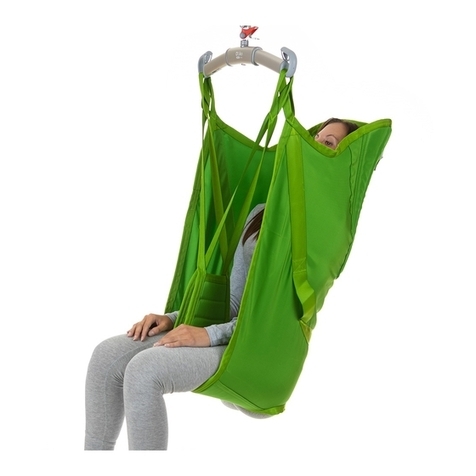
Hillrom
Hillrom Liko UniversalSling User manual
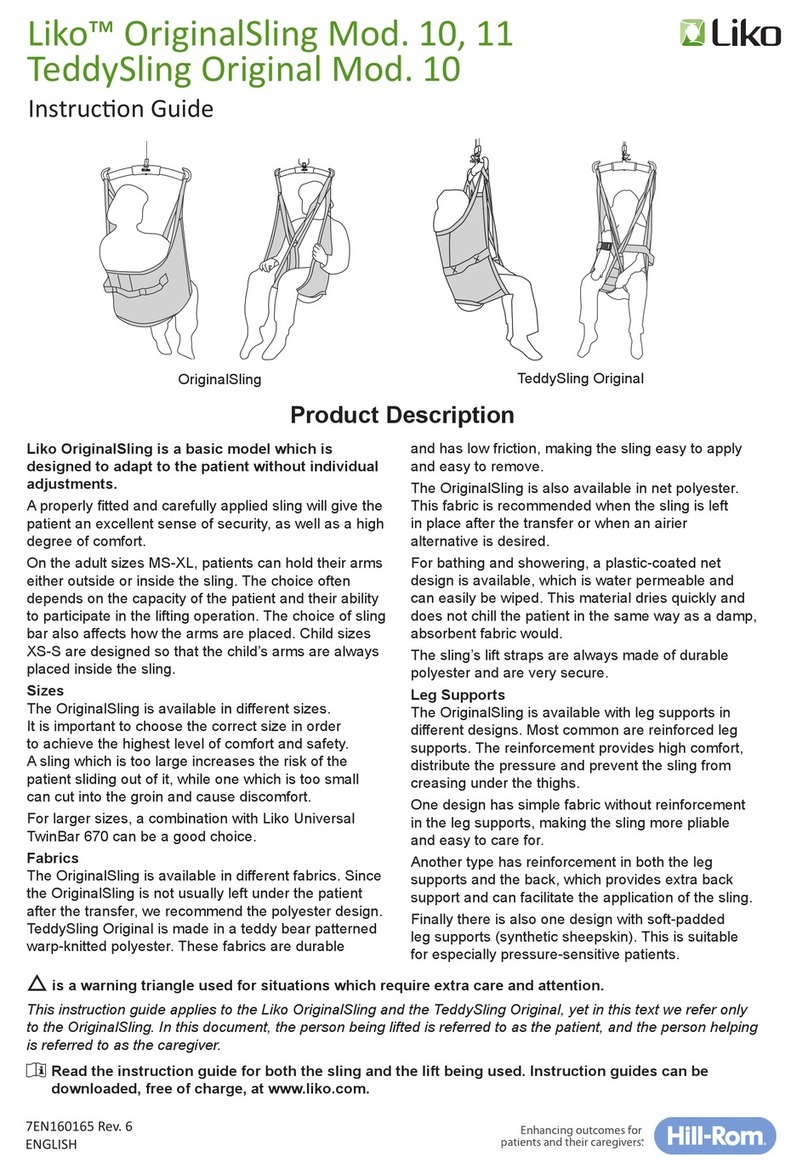
Hillrom
Hillrom Liko OriginalSling 11 User manual

Hillrom
Hillrom Liko HygieneSling with SafetyBelt 45 User manual

Hillrom
Hillrom Liko OriginalSling 10 Manual
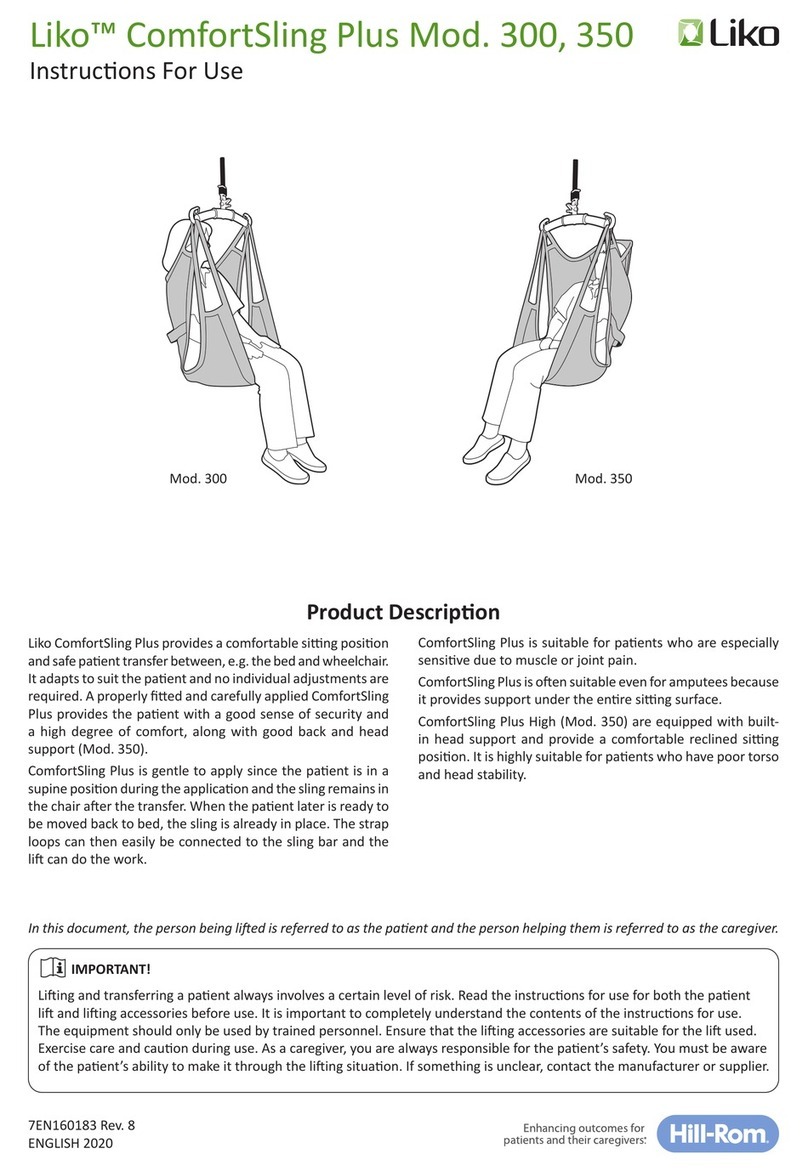
Hillrom
Hillrom Liko ComfortSling Plus 300 User manual

Hillrom
Hillrom Liko MasterVest 60 User manual
Popular Sling manuals by other brands
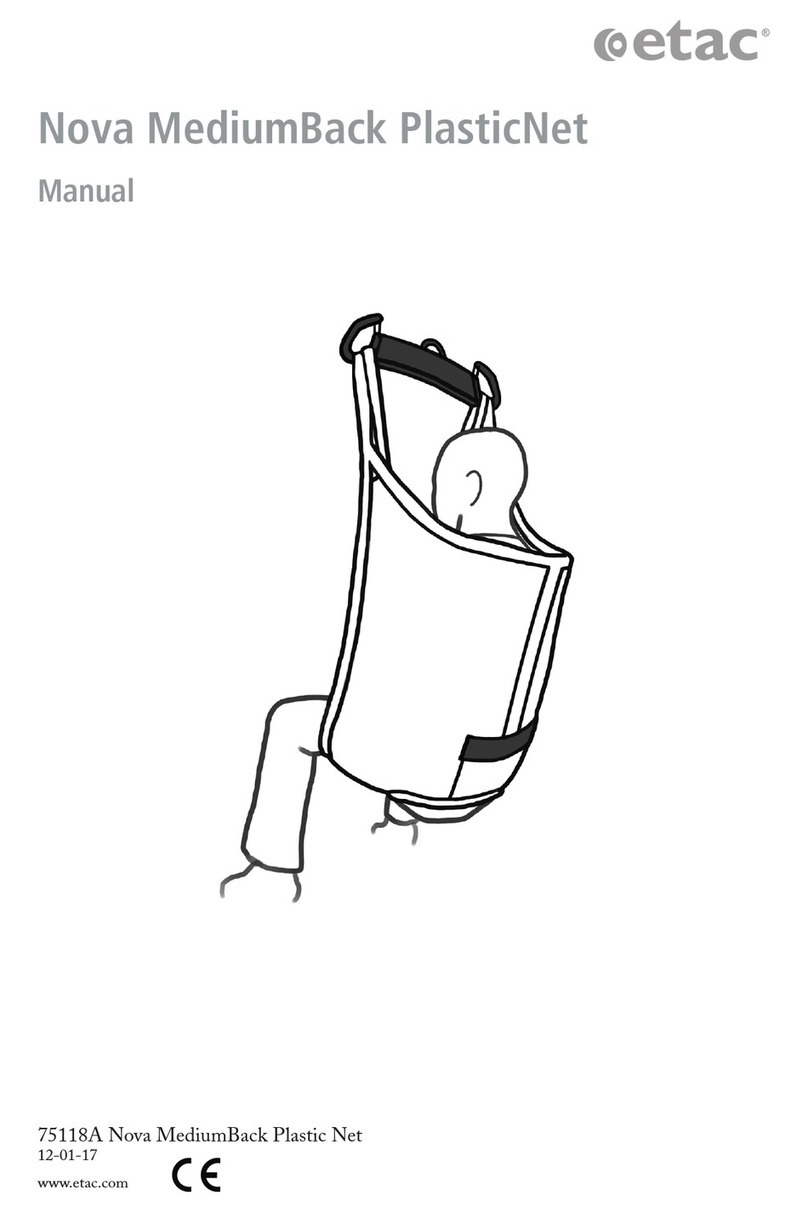
Etac
Etac Nova MediumBack PlasticNet manual
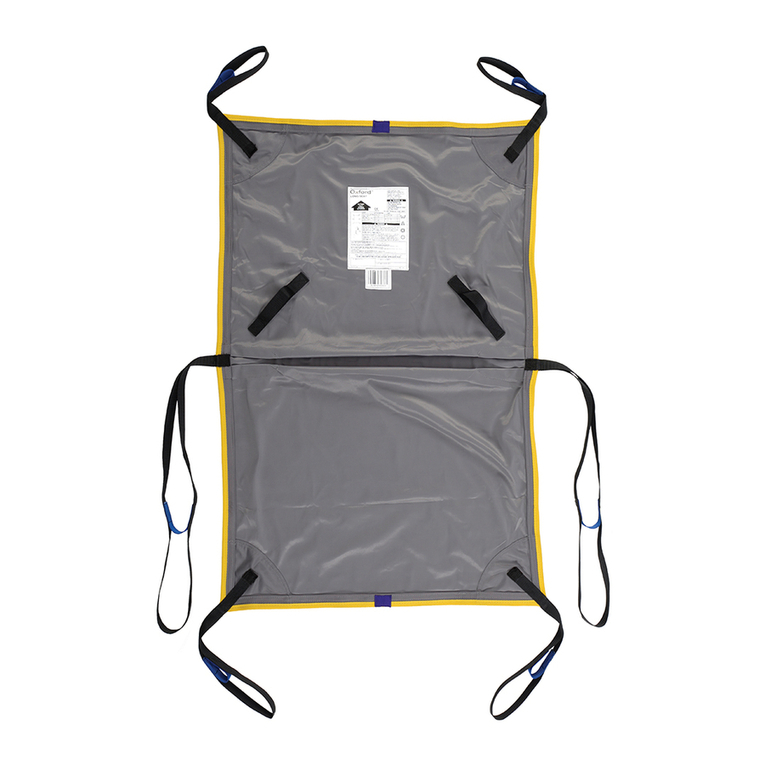
Joerns
Joerns Oxford Long Seat User instruction manual
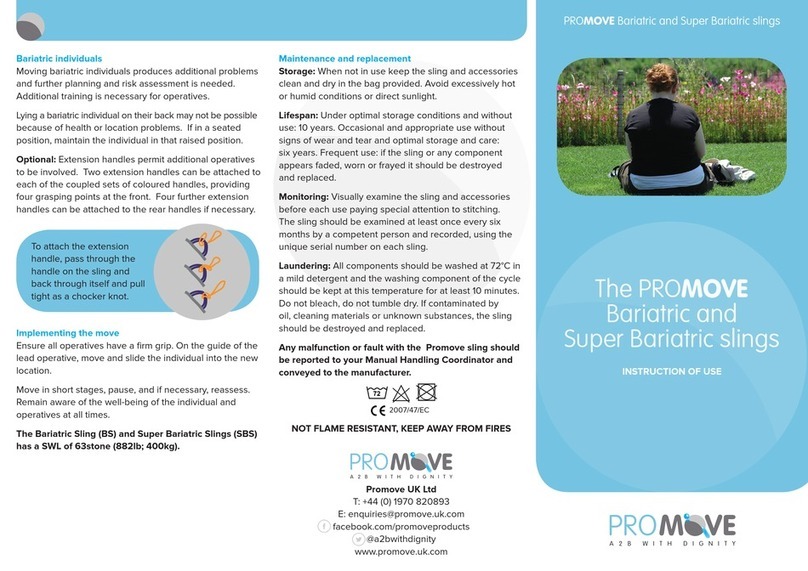
Promove
Promove Bariatric Instructions for use
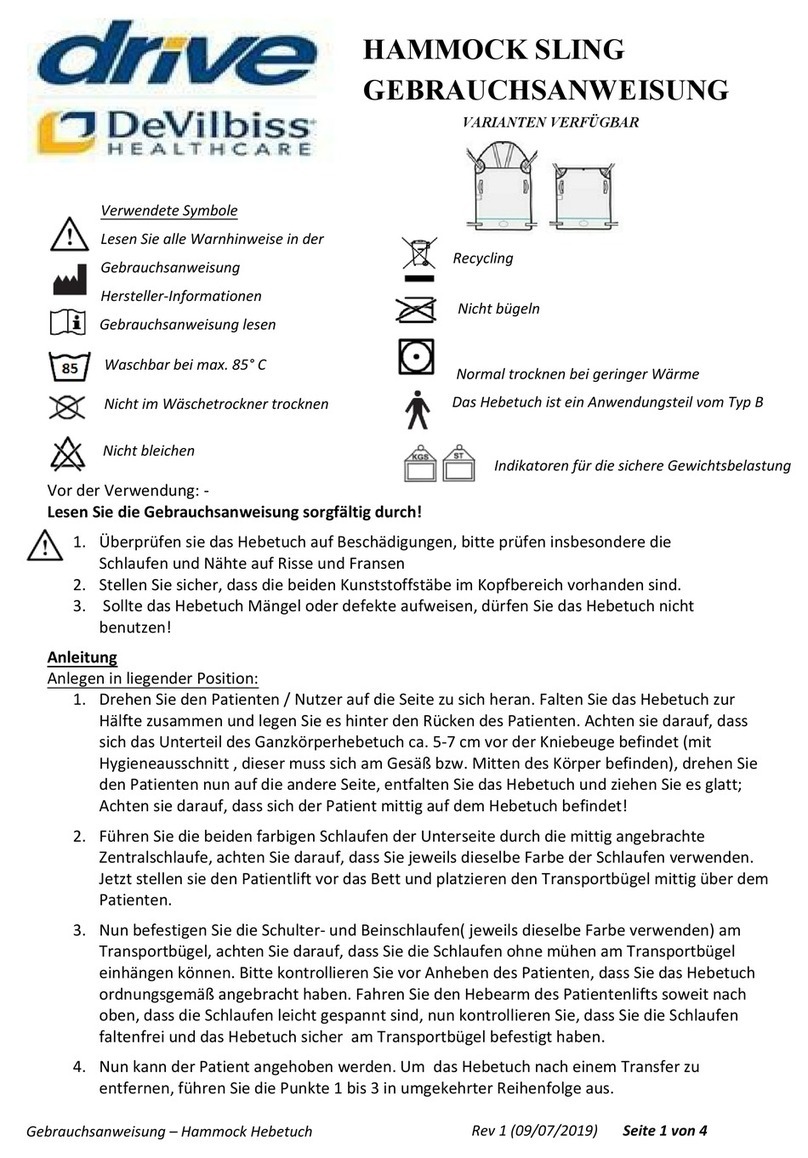
Drive DeVilbiss Healthcare
Drive DeVilbiss Healthcare HAMMOCK SLING Instructions for use

Liko
Liko SilhouetteSling 22 Instruction guide
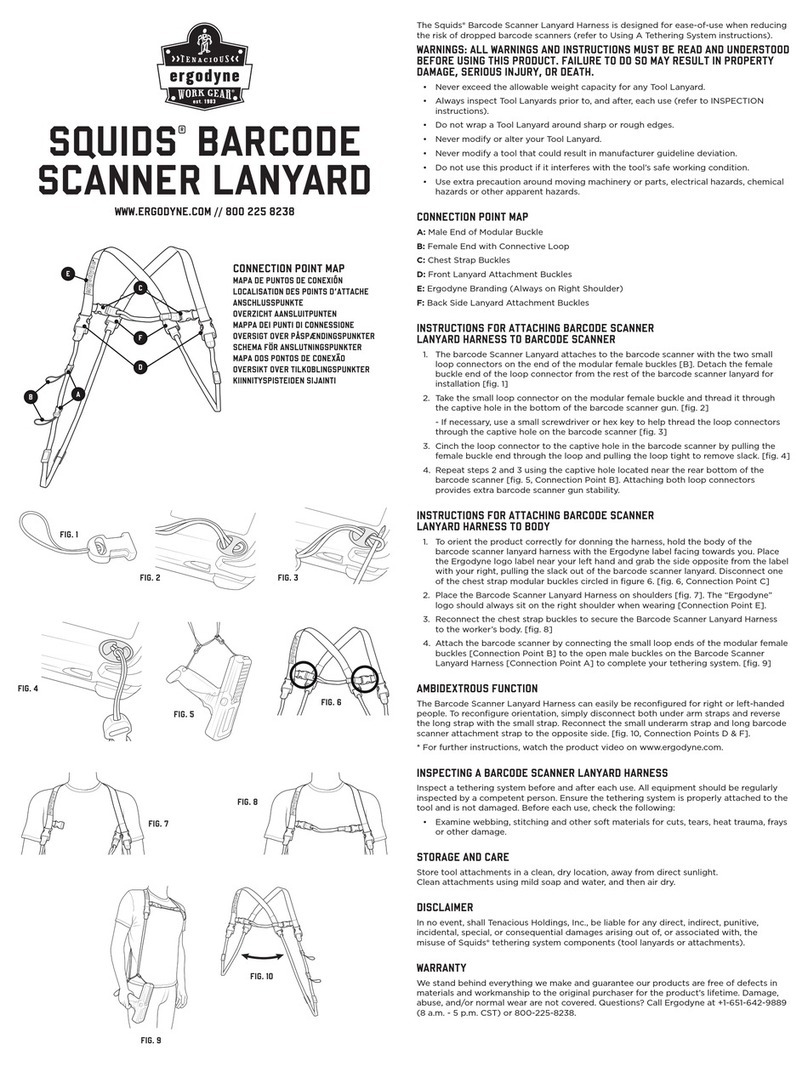
ERGODYNE
ERGODYNE SQUIDS 3132 quick start guide

